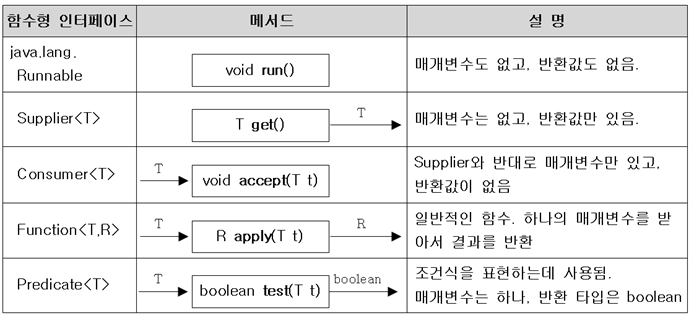java.util.function 패키지
- 자주 사용되는 다양한 함수형 인터페이스를 제공
매개변수 하나인 함수형 인터페이스

1. Supplier<T>
- 반환만
@FunctionalInterface public interface Supplier<T>{ T get(); }
예)
Supplier<String> supplier = () -> "Hello World!";
System.out.println(supplier.get());
//Hello World!2. Consumer<T>
- 매개변수만
@FunctionalInterface public interface Consumer<T> { void accept(T t); default Consumer<T> andThen(Consumer<? super T> after) { Objects.requireNonNull(after); return (T t) -> { accept(t); after.accept(t); }; } }
andThen()
- 하나의 함수가 끝난 후 다음 Consumer를 연쇄적으로 이용할 수 있다.
- andThen'()' 요걸 나중에!
예)
Consumer<String> consumer = (str) -> System.out.println(str.split(" ")[0]);
consumer.accept("Hello World");
//Hello
consumer.andThen(System.out::println).accept("Hello World");
//Hello
//Hello World- 먼저 accept()로 받아들인 Consumer를 먼저 처리하고
- andThen()으로 받은 두번째 Consumer를 처리한다.
- 👀왜
[0]?? :"Hello World"라는 문자열 하나만 받았기에 - ✨✨accept()로 문자열을 분할했어도, 원본의 데이터는 유지된다.
-> 👀👀왜?? : 함수형에서 함수는 값의 대입 또는 변경 등이 없기 때문에!!
3. Function<T, R>
@FunctionalInterface public interface Function<T, R> { R apply(T t); default <V> Function<V, R> compose(Function<? super V, ? extends T> before) { Objects.requireNonNull(before); return (V v) -> apply(before.apply(v)); } default <V> Function<T, V> andThen(Function<? super R, ? extends V> after) { Objects.requireNonNull(after); return (T t) -> after.apply(apply(t)); } static <T> Function<T, T> identity() { return t -> t; } }
andThen()
- 하나의 함수가 끝난 후 다음 Consumer를 연쇄적으로 이용할 수 있다.
- andThen'()' 요걸 나중에!
compose()
- 첫번째 함수 실행 이전에 먼저 함수를 실행하여 연쇄적으로 연결해준다.
- compose'()' 요걸 먼저!!
static identity()
- 자기 자신을 반환하는
static함수
예)
Function<String, Integer> function = str -> str.length();
function.apply("Hello World");
//암것도 안나옴...
System.out.println(function.apply("Hello World"));
//114. Predicate<T>
@FunctionalInterface public interface Predicate<T> { boolean test(T t); default Predicate<T> and(Predicate<? super T> other) { Objects.requireNonNull(other); return (t) -> test(t) && other.test(t); } default Predicate<T> negate() { return (t) -> !test(t); } default Predicate<T> or(Predicate<? super T> other) { Objects.requireNonNull(other); return (t) -> test(t) || other.test(t); } static <T> Predicate<T> isEqual(Object targetRef) { return (null == targetRef) ? Objects::isNull : object -> targetRef.equals(object); } @SuppressWarnings("unchecked") static <T> Predicate<T> not(Predicate<? super T> target) { Objects.requireNonNull(target); return (Predicate<T>)target.negate(); } }
예)
Predicate<String> predicate = (str) -> str.equals("Hello World");
System.out.println(predicate.test("Hell")); //false
System.out.println(predicate.test("Hello")); //false
System.out.println(predicate.test("Hello World")); //truePredicate의 사용법

- ✨✨원래
Predicate<T,R>이지만, 반환타입이 항상Boolean이기 때문에 뒤는 쓰지 않는다.
->Predicate<T>
Quiz.
아래의 빈칸에 알맞은 함수형 인터페이스를 적으시오.

① Supplier<Integer>
② Consumer<Integer>
③ Predicate<Integer>
④ Function<Integer, Integer>
매개변수가 2개인 함수형 인터페이스(Bi~)

매개변수 3개라면? 직접 정의한다.

(매개변수 타입==반환 타입) 일치하는 함수형인페
- 단항연산자, 이항연산자
- 타입이 같기 때문에
<T>하나!

ex14_02_1
import java.util.ArrayList;
import java.util.List;
import java.util.function.Consumer;
import java.util.function.Function;
import java.util.function.Predicate;
import java.util.function.Supplier;
public class Ex14_02_1 {
public static void main(String[] args) {
Supplier<Integer> s = () -> (int)(Math.random()*100)+1; //1<=x<101
Consumer<Integer> c = i -> System.out.print(i+", "); //출력
Predicate<Integer> p = i -> i%2==0; //짝수인지 검사
Function<Integer, Integer> f = i -> i/10*10; //**일의 자리 없애기
List<Integer> list = new ArrayList<>();
makeRandomList(s, list);
System.out.println(list);
printEvenNum(p, c, list);
List<Integer> list2 = eraseIll(f, list);
System.out.println(list2);
}
//Supplier s를 받아(1~100 난수를 받아) list에 추가
static <T> void makeRandomList(Supplier<T> s, List<T> list) {
for(int i=0; i<10; i++)
list.add(s.get());
}
//list를 받아 Predicate p로 짝수인지 검사하고, Consumer c로 출력
static <T> void printEvenNum(Predicate<T> p, Consumer<T> c, List<T> list) {
System.out.print("[");
for(T i : list) { //**list의 모든요소 하나하나를 Integer i에 넣어서
if(p.test(i)) //i가 짝수면 true, 홀수면 false
c.accept(i);//짝수면 Consumer 람다식대로 출력
}
System.out.println("]");
}
//list와 같은 크기의 새 List를 만들어, Function f로 일의 자리 없애고 그 새 List에 저장
static <T> List<T> eraseIll(Function<T, T> f, List<T> list) {
List<T> newList = new ArrayList<T>(list.size()); //new ArrayList<T>(크기)
for(T i : list)
newList.add(f.apply(i)); //일의 자리를 없애서 새 newList에 저장
return newList; //그 newList 반환, [요소1, 요소2, ...]
}
}[99, 2, 69, 89, 7, 83, 63, 50, 42, 20]
[2, 50, 42, 20, ]
[90, 0, 60, 80, 0, 80, 60, 50, 40, 20]